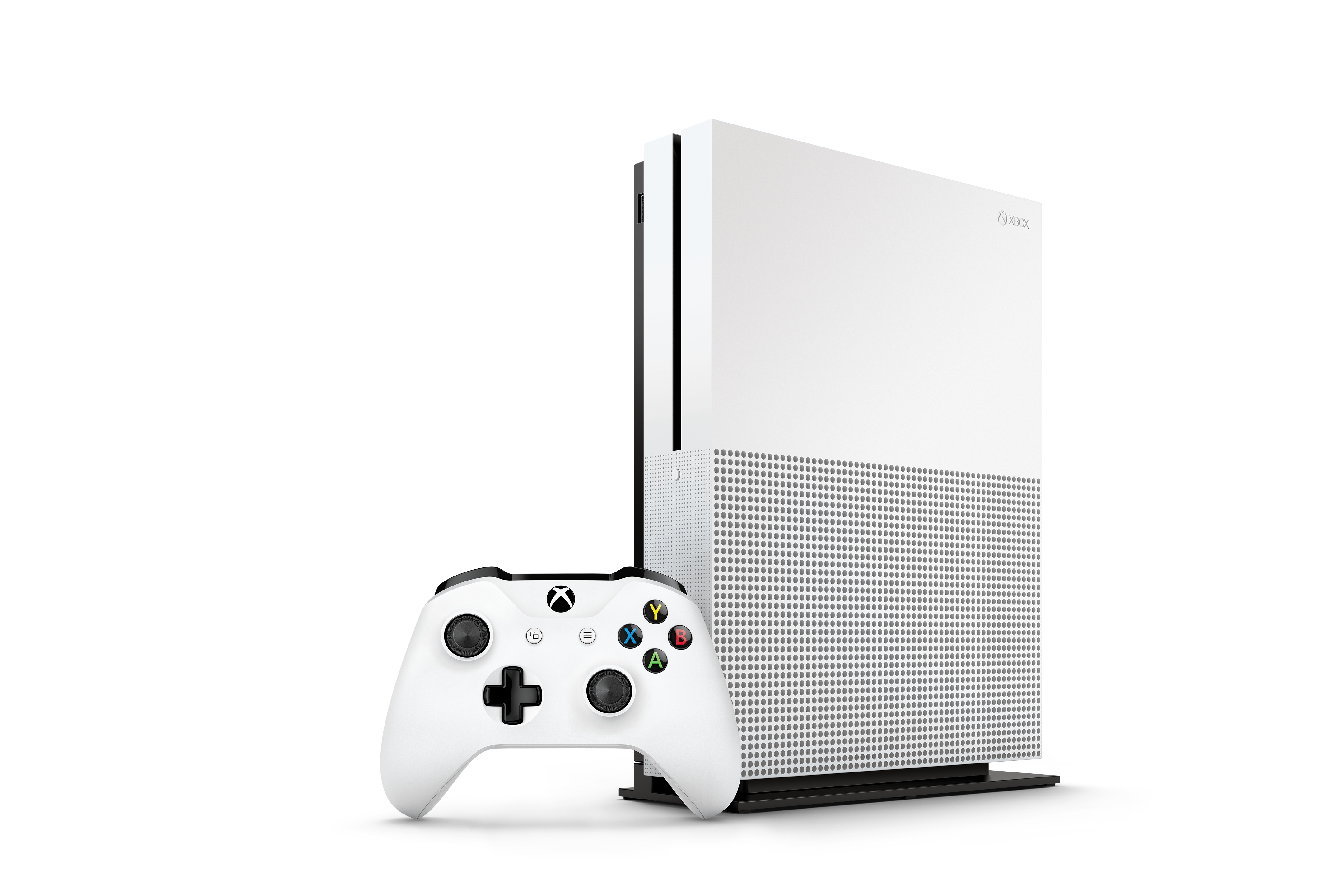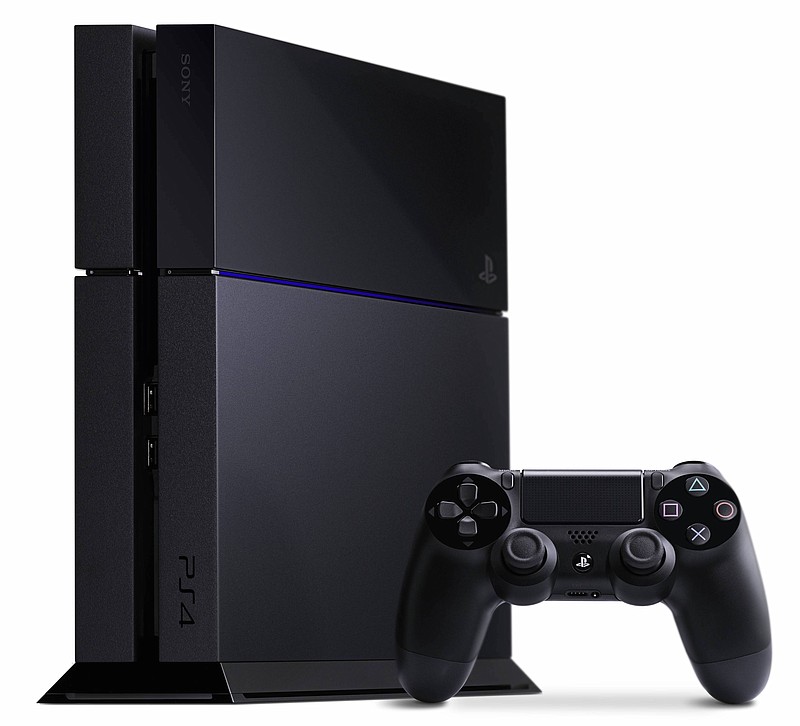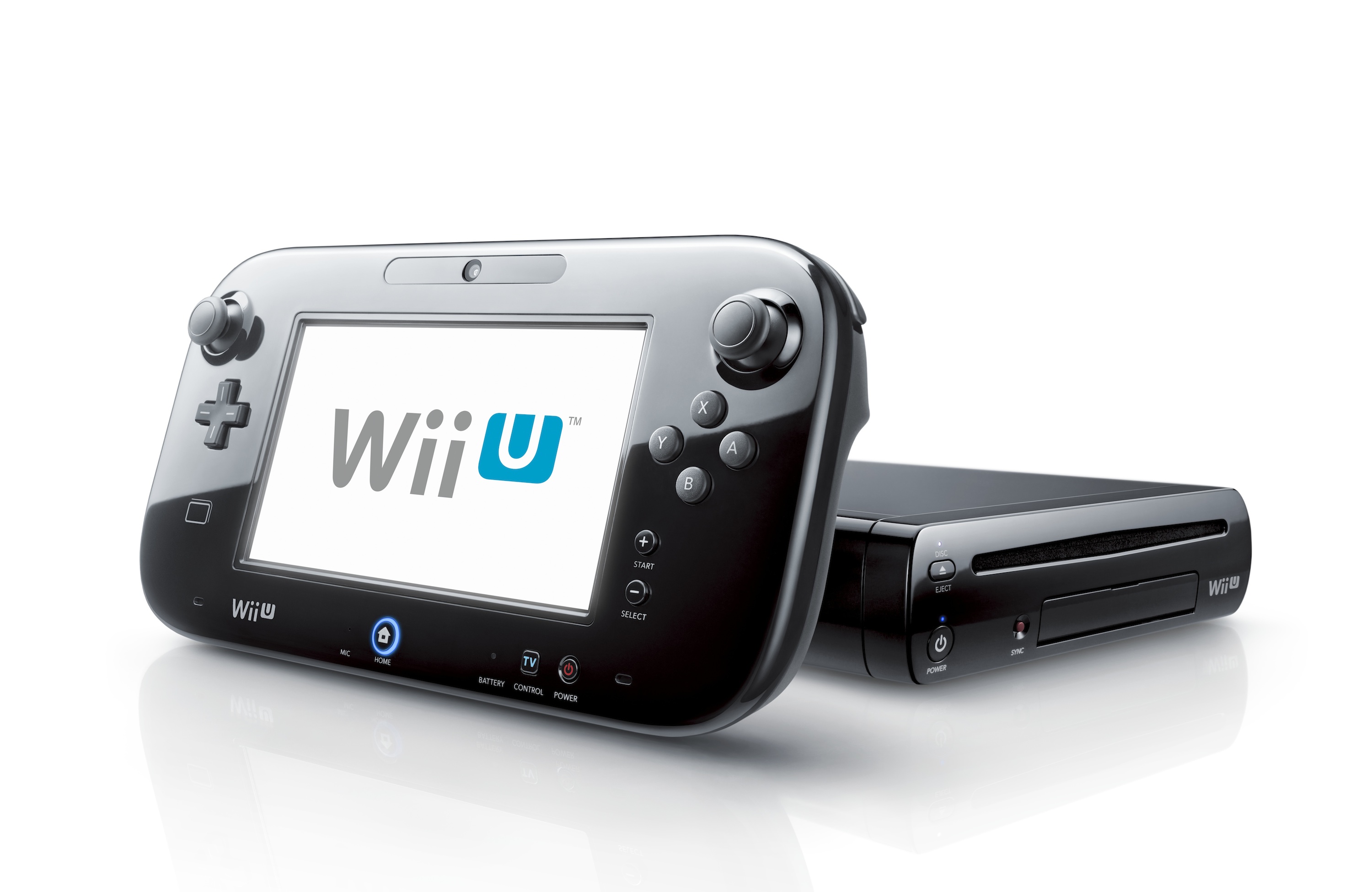 The Xbox One S is a slimmed-down, slightly feature-enhanced version of the Xbox One console, which was released in November 2013. The One S is being released Tuesday. An even more powerful follow-up to the Xbox One and One S, code-named Project Scorpio, is slated for release during the 2017 holidays.
The Xbox One S is a slimmed-down, slightly feature-enhanced version of the Xbox One console, which was released in November 2013. The One S is being released Tuesday. An even more powerful follow-up to the Xbox One and One S, code-named Project Scorpio, is slated for release during the 2017 holidays.Meet the Xbox One S
Coming three years after the release of the Xbox One - but more than a year before Microsoft's more powerful Project Scorpio device - the Xbox One S is being released today, offering a few key updates to the original console's design. - Sleeker, slimmer - The Xbox One S comes in a case that is slimmer and 40 percent smaller than the original Xbox One. Rather than having to plug in an additional, corded power brick, the S model's power supply is integrated internally. - Improved graphics -The Xbox One S supports color with a high dynamic range, or HDR, which offers greater contrast between light and dark sections for a more vivid presentation. Select titles, such as "Forza Horizons 3" and "Gears of War 4," support HDR. - Sharper video - The Xbox One S supports streaming 4K resolution video and plays Ultra HD optical media, each of which benefits from the improved visual clarity offered by HDR. The original Xbox One was limited to displaying content at 1080p resolution. - Cheaper - The original Xbox One debuted in November 2013 at $500, including a Kinect camera. The Xbox One S doesn't include the Kinect but will sell for $299 to $450, depending on hard-drive size - 500 gigabytes to 2 terabytes - and whether a game is included. ' The console will have an eight-core central processor. Its graphics processor will be powerful enough to support gaming in 4K resolution, generating visuals with four times as much detail as the standard high-definition supported by the Xbox One. - The system will support virtual-reality gaming, at least one example of which will be landmark 2015 hit "Fallout 4." - Project Scorpio and Xbox One are being touted as part of the same device "family." Games and accessories will work for either system.
The next generation: What we know.
Nintendo, Microsoft and Sony have released precious few details about the NX console or Project Scorpio and Neo, the upcoming refreshes to the existing Xbox One and PlayStation 4. Here's what's been confirmed:- Sony's Neo Sony confirmed the existence of the device in June. Its release date hasn't been announced. - Neo will be a "high-end PS4" targeting hardcore gamers and those with access to 4K-resolution TVs, which will be necessary to eke the most benefit out of the system. - Neo will cost more than the baseline PS4, which currently retails for $350 with a bundled game. However, both systems will be for sale simultaneously. - All games released for Neo also will be playable on the standard PS4 and "all or a very large majority of [PS4] games will also support [Neo]." - Neo will work with Sony's virtual-reality headset, PlayStation VR, which will be available Oct. 13 for $400.Nintendo's NX- Nintendo confirmed the NX's existence in March 2015. It is slated to release March 2017.- The device will be a "brand new concept" and offer "a new way of playing games," implying a shift away from a traditional console design.- Nintendo expects Wii U sales to slow with the release of NX, but company says the new device isn't a successor to the Wii U console or the 3DS handheld.- The NX will focus on providing compelling content over pushing the envelope in terms of faster hardware.- Games announced to appear on the NX include "The Legend of Zelda: Breath of the Wild," "Dragon Quest X," "Dragon Quest XI" and "Pikmin 4."- Rumored: The NX will be a console/handheld hybrid that eschews optical discs in favor of games stored on cartridges. It will be powered by Nvidia's Tegra X-line of mobile.Microsoft's Project Scorpio- Microsoft confirmed Project Scorpio's existence in June. It is scheduled to release in holidays 2017.The company is billing Scorpio as "the most powerful console ever" and a device that will "move Xbox forward."- The console will have an eight-core central processor. Its graphics processor will be capable of 6 trillion floating point operations per second and is designed to handle games at 4K resolution.- The system will support virtual reality gaming, at least one example of which will be landmark 2015 hit "Fallout 4."- Project Scorpio and Xbox One are being touted as part of the same device "family." Games and accessories will work for either system.Source: Financial Times, The Verge, NeoGAF, Bloomberg, Sony, Microsoft, Nintendo Oct. 1985: Nintendo Entertainment System
A timeline of consoles
- Nintendo Aug. 1991: Super NES Sept. 1996: Nintendo 64 Nov. 2001: Gamecube Nov. 2006: Wii Nov. 2012: Wii U - Average time between generations - 5 years 5 months - Sony Sept. 1995: Play- Station Oct. 2000: Play- Station 2 Nov. 2006: Play- Station 3 Nov. 2013: Play- Station 4 - Average time between generations - 6 years 1 month - Microsoft Nov. 2001: Xbox Nov. 2005: Xbox 360 Nov. 2013: Xbox One - Average time between generations - 6 years - Industry-wide average time between console generations - 5 years 4 months, including systems made by Atari and Sega
In late 2013, James Wilson was one of a million gamers who queued up to buy the newly launched PlayStation 4 video game console.
To video game fans, purchasing a new console is traditionally seen as a fairly long-term investment. For an entry fee of a few hundred dollars, owners of a PlayStation, Xbox or the latest hardware from Nintendo can expect to play new releases for several years before needing to upgrade to a more powerful successor.
Wilson, a former manager at video game retailer GameStop, anticipated that his PlayStation 4 would enjoy a comparable lifespan to his previous system, the Xbox 360, which was supported by developers for eight years.
In the last several months, however, Sony and Microsoft have confirmed rigorous development of follow-ups to the less-than-3-year-old PlayStation 4 and Xbox One. Code-named Neo and Project Scorpio, respectively, these devices are slated for arrival - or expected by analysts to arrive - by the end of 2017.
"It seems a little like a slap in the face," Wilson, 37, says. "Everyone expected [the PlayStation 4 and Xbox One] to be 10-year systems, too. Now it's getting cut short."
Sony and Microsoft are billing Neo and Project Scorpio as a kind of technological "bridge" - midcycle updates to the PlayStation 4 and Xbox One - rather than a new generation of hardware in the traditional sense. The new systems' technical specifications haven't been detailed, but announcements at the Electronics Entertainment Expo in June confirmed that they will feature faster processors designed to support emerging game technologies such as virtual reality and ultra-high-definition 4K graphics.
In the 40-year history of home video gaming, hardware manufacturers have released new consoles at an average rate of one every five years and four months. However, the last generation of consoles, the PlayStation 3 and Xbox 360, lasted an average of seven and a half years apiece, more than 40 percent longer than the industry standard.
When the follow-ups to those long-lived systems, the Xbox One and PlayStation 4, launched in November 2013, many in the gaming industry predicted that they, too, would enjoy a similar lifespan, if not an even longer one.
"We're probably here for a while because we're built for the future," Craig Flannagan, Microsoft Canada's director of Xbox marketing, said in a 2014 interview with GamesIndustry. "[The Xbox One] is a console that will last you, conservatively, a decade, if I had to put a bet down today."
Bad bet.
Thanks to the widespread acceptance of two-year upgrade plans offered by most smartphone carriers, the public now expects technology to update more quickly than is traditional in the gaming industry, said Sony Interactive Entertainment President and Group CEO Andrew House during a June 10 interview with the Financial Times newspaper.
"The consumer is attuned to a different cadence of innovation in technology thanks in great part for the upgrades cadence on mobile phones or PCs," he said.
All in the family
Even though some gamers say Neo and Project Scorpio sound like a generational leap forward, Sony and Microsoft have stressed that the new consoles are within the same "device family" as their existing systems. Consequently, content released for the new systems also can be played on the PlayStation 4 and Xbox One.
"[Neo] is intended to sit alongside and complement the standard PS4," House told the Financial Times. "We will be selling both [versions] through the life cycle."
Microsoft and Sony aren't alone in pushing their hardware forward ahead of schedule.
In April, Nintendo announced a follow-up to its Wii U console. Code-named the "NX," the device is slated for release in March 2017, less than four and a half years after the Wii U and a year sooner than the company's traditional generation gap.
Unlike Neo and Project Scorpio, however, the NX is being billed as a true next-generation project rather than a companion update to Nintendo's existing hardware.
"I can assure you we're not building the next version of Wii or Wii U," Tatsumi Kimishima, Nintendo president, said in a 2015 interview with Time magazine. "It's something unique and different. It's something where we have to move away from those platforms in order to make it something that will appeal to our consumer base."
Even if Sony and Microsoft are billing Neo and Project Scorpio as performance updates rather than successors to their existing consoles, some gamers say they're baffled by the industry-wide decision to improve on systems so early in their expected life cycle.
"There are a lot of people who are upset about it," says Chattanoogan Rickie Blevins. "That's why [Microsoft and Sony] put this spin on it like, 'It'll do 4K now. It'll do VR now.' That's their way of mitigating the damage of having a shorter life cycle."
A 40-year-old, lifelong gamer, Blevins and his wife, Shellina, own a PlayStation 4, Xbox One and Nintendo Wii U, in addition to legacy consoles dating back to before the original Nintendo Entertainment System. Despite owning hardware that soon may be outdated, Blevins says he's not interested in upgrading to either Neo or Project Scorpio.
"[We] currently don't have a 4K TV, so we wouldn't be able to use that functionality, and we haven't really thought about doing the VR stuff," he says. "As far as the main upgrades these things are going to do, they aren't things we're currently prepared to do or will be doing in the near future."
Despite his lack of enthusiasm for Neo and Project Scorpio, Blevins says he's "very excited" about Nintendo's new device, which is rumored to be a hybrid of a handheld device and a traditional console.
"[The hybrid design] makes it easier for them to break out of the home unit paradigm," he says. "If it's a handheld, I'm going to be super-excited."
Consequently, though, he'll have to buy one for his wife, too, he says.
THE COST OF PROGRESS
Chattanooga-based solutions engineer Matt Brown used to own a PlayStation 3, but he's largely stayed out of the console realm during the current hardware generation. Instead, he says, he prefers to play games on the custom-built, high-end gaming PC his brother-in-law assembled for him.
While the 30-year-old says he's not interested in owning a PlayStation 4 or Xbox One, he's excited at the prospect of using Neo or Project Scorpio to experience virtual and augmented reality via the PlayStation VR or HoloLens headsets.
If creating devices capable of properly taking advantage of that kind of emerging technology means Microsoft and Sony have to issue new hardware more quickly, that's the cost of staying ahead of the curve, Brown says.
"I don't think you can really get mad about that," he says. "iPhone users have this all the time because they'll upgrade to the latest thing and, a year later, the next iPhone comes out and it's so much better. That's the price you pay for wanting to be an early adopter.
"Broadly speaking, I think it'll probably upset some hardcore gamers, but what do you do as a company? Not innovate? I can't blame them. They can't just stand still."
Contact Casey Phillips at cphillips@timesfreepress.com or 423-757-6205. Follow him on Twitter at @Phillips CTFP.

